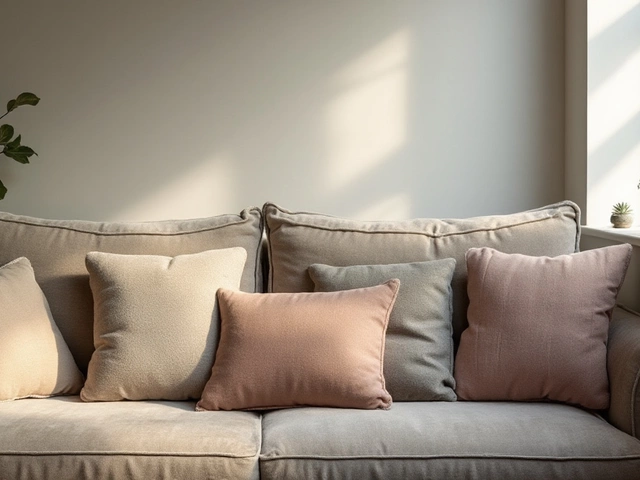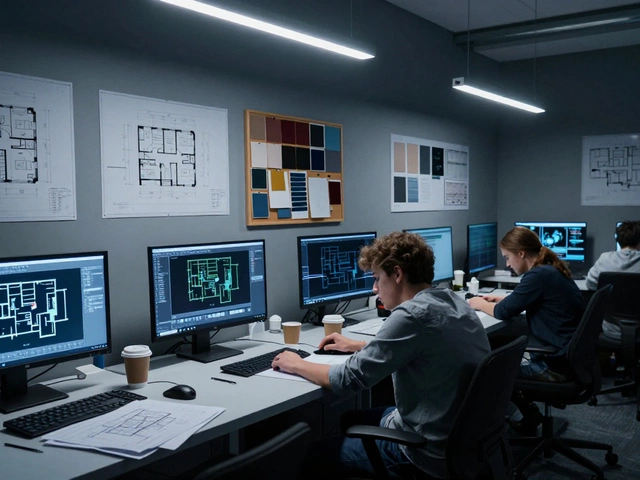
If you walk into a perfectly put-together room and think, “I could totally do this better,” you’re already halfway there. Interior design is more than picking out throw pillows or guessing where the couch should go—it’s about problem solving, planning, and seeing the world through a creative lens.
It doesn’t matter if you’ve been obsessed with HGTV since you were twelve or just realized your office cubicle feels like a prison cell. This field is packed with different roles and project types. From revamping tiny apartments for city dwellers to helping companies build coworking spaces that don’t suck, the range is huge.
What catches most people off guard? Interior design mixes creativity and practicality every single day. Yes, you’ll get to play with color swatches, but you’re also juggling budgets, timelines, and crazy client requests. If you want to actually make a living from this, it pays to understand what the job really looks like before you dive in.
- Understanding What Interior Designers Really Do
- Deciding if Interior Design Fits Your Style
- Learning and Training: Degrees, Certificates, and Self-Taught Paths
- Building a Portfolio Without Experience
- Networking and Landing Your First Real Projects
- What Comes Next: Growing in the Industry
Understanding What Interior Designers Really Do
Interior designers do way more than just pick colors and furniture. They’re problem solvers for spaces, whether it’s someone’s home, a dentist’s office, or the coolest new cocktail bar downtown. At the core, a interior design career is about shaping environments that look good and actually work for the people using them.
Day-to-day, designers dive into stuff like floor plans, lighting, furniture layouts, and even safety codes. You’ll see them scribbling on blueprints, talking with contractors, and breaking down budgets. The job means talking to lots of different folks—clients, engineers, carpenters—to make sure the details line up perfectly.
Real-world projects always come with curveballs. Maybe your client’s kid needs a sensory-friendly room or a restaurant owner wants to squeeze in more tables without making it feel crowded. Designers translate these wishes into doable designs, choosing the right materials and finding creative fixes to awkward spaces.
Interior designers also keep up with trends, but not just to stay stylish. There‘s a lot happening with eco-friendly designs, smart home tech, and flexible workspaces that didn’t even exist ten years ago. Most successful designers know how to blend the new with the classic, and they have an eye for what will last, not just what’s hot on social media.
- They create digital models and 3D renderings to show clients what to expect (think: realistic walk-through videos, not just mood boards).
- They source materials—fabrics, flooring, light fixtures—often at trade discounts clients can’t get themselves.
- They make sure everything meets building codes and passes inspections. Forgetting this part = major headaches.
No surprise: interior designers are master multitaskers. If you love the idea of juggling different projects and handling details people barely notice but totally appreciate, you’ll probably fit right in.
Deciding if Interior Design Fits Your Style
Let’s get real: being interested in interior design isn’t always the same as loving the job itself. The everyday work goes way beyond mood boards. Are you ready to work closely with clients who sometimes have wild ideas, or manage contractors who text you about paint drying at seven in the morning? If that sounds interesting instead of stressful, you’re probably in the right place.
Big plus: good interior designers are part artist and part project manager. There’s a reason the Bureau of Labor Statistics says attention to detail is huge in this field—half the work is listening to what people actually want (sometimes when they don’t even know themselves) and turning that into real spaces.
- You love organizing spaces and just naturally notice when things “feel off.”
- You don’t mind handling a bit of math, budgeting, or drawing up basic floor plans—yeah, you’ll use those skills.
- You’re comfortable with feedback and can handle when someone doesn’t like your first idea.
- You’re curious and follow design trends, but aren’t stuck needing everything to look like a Pinterest board.
If these sound like you, you’re already ahead of most beginners who just like picking out furniture.
Here’s a quick look at what successful interior designers say they actually spend time on:
| Task | % of Time |
|---|---|
| Meeting with clients | 25% |
| Drafting designs/plans | 20% |
| Managing projects (budgets, timelines) | 20% |
| Sourcing furniture & materials | 15% |
| Handling paperwork & admin | 10% |
| Marketing/networking | 10% |
The point? If you want a career where your creativity actually gets used—but you’re also cool juggling schedules, working with all types of people, and seeing designs through from sketch to reality—then keep going. If you just like posting mood boards for fun or get bored working out details, it might make you miserable.
Learning and Training: Degrees, Certificates, and Self-Taught Paths
So how do you actually learn the stuff that matters in interior design? You’ve got options—and a lot of people blend a little of everything.
First, there’s the college route. Plenty of designers get a bachelor’s degree in interior design or interior architecture. These programs actually make a difference because they cover real-life skills: drafting floor plans, understanding building codes, color theory, lighting, and even how to work with clients. The Council for Interior Design Accreditation (CIDA) stamps its approval on legit programs in the US, and employers tend to notice that.
If a full degree sounds like too much, tons of community colleges and trade schools offer shorter certificates. Usually, you’re looking at a year or less, and it’s plenty to get you started on entry-level projects or help you figure out if this is really your thing. These courses focus heavily on practical software like AutoCAD, SketchUp, and sometimes Revit. If you’re not tech-savvy now, you will be after a term or two.
Not everyone wants to go to school for years or rack up student loans. Good news: people break into interior design by being self-taught all the time. The key is treating your learning like a job—not just scrolling through pretty rooms on Instagram. Some ways people actually get skills on their own:
- Online courses: Platforms like Coursera, Udemy, and Domestika have solid classes from practicing designers. There are even free courses if you want to test the waters.
- YouTube deep dives: Plenty of designers share full project walkthroughs, mistakes, and tips for beginners. It's not always fancy-looking, but the advice is real.
- Books and design blogs: Look for newer titles and blogs run by working designers—trends and standards change fast, and old books can be way out of date.
- Practice and feedback: Redesign your own room, do mock projects for friends, or join online communities where people give honest feedback. This helps you build real skills and spot what you still need to learn.
Fun fact: In some states and countries, if you want to call yourself a “licensed interior designer,” you need to pass the NCIDQ exam after finishing a certain amount of educational hours and real work experience. But a lot of designers start unlicensed—just make sure you know the rules where you live, especially if you want to work on things like hospitals or big commercial projects.
No single path is clearly better than the others. The main thing is always learning, staying up on the latest trends, and building projects you can actually show people. However you start, make sure you’re picking up practical skills, not just random theory.

Building a Portfolio Without Experience
Getting started in interior design feels tough when you have nothing to show. But here’s the secret: almost everyone starts with zero clients and a blank page. Your goal is to make people see what you can do—even if it’s not paid work (yet).
Start at home. Redesign your bedroom, a friend’s living room, or even your parents’ kitchen. Take before-and-after photos from the same angle and in good lighting. These shots show your eye for layout, color, and smart fixes. It’s not just about pretty pictures—caption them. Say interior design choices out loud: "Why did you pick this paint? What problem did you solve?"
Don’t overlook digital tools. Free software like SketchUp or easy drag-and-drop apps let you create virtual room designs from your laptop. Put together mood boards for imaginary clients—think “Cozy Home Office for a Freelancer” or “Minimalist Kitchen Makeover.” You’re proving you know how to organize a space and make it look good.
- Offer to redo a dorm room or help a local café shuffle their seating. Most small businesses love a free upgrade, and you get a real-life project for your portfolio.
- Join online design challenges. Sites like Roomstyler and Houzz run contests for beginner and amateur designers. Even a second-place finish means your work gets some eyeballs.
- Document everything. Use Instagram, Pinterest, or a basic website as your online home. Don’t wait until you have “real” work—start posting inspirations, mock-ups, and your progress.
You don’t need a fancy camera or an expensive project to show what you can do. Just do the work somewhere, snap it, talk through it, and keep adding to your portfolio as you go. You’re looking for steady growth—not instant perfection.
Networking and Landing Your First Real Projects
You might have killer taste and a sharp eye for design, but those won’t mean much unless you connect with the right people. Networking isn’t just a buzzword. It’s how most folks break into the interior design world, especially if you’re new or switching careers. Word of mouth and referrals are gold in this field.
Start by joining legit professional groups like ASID (American Society of Interior Designers) or IIDA (International Interior Design Association). These aren’t just about meetings and newsletters—the real value is the job boards, design competitions, and local events where you can meet mentors and potential clients face-to-face. In a 2023 survey by Houzz, 45% of new designers said their first paying projects came from someone they met through industry events or design meetups. So, showing up really works.
Don’t wait to have a massive portfolio before spreading the word. Build an online presence with Instagram, TikTok, or Pinterest. Show before-and-afters, mood boards, and design tips—stuff people find helpful or want to share. Use simple captions and real talk; friends of friends are more likely to reach out if they see you’re steadily working on something (even if it’s just your roommate’s kitchen).
- Offer pro-bono or discounted designs for family, friends, or local businesses—only a few projects can jumpstart your credibility.
- Create a basic website using platforms like Wix or Squarespace. Include short bios, photos, client testimonials (even if from folks you know), and a way to contact you directly.
- Host mini-workshops at community centers or online. A quick “How to make your living room pop” session can land you a client who wants more hands-on help.
Don’t underestimate DMs. Some designers land their first gig just by reaching out to local realtors or small business owners on social media. Make your pitch short, friendly, and show samples of your work, even if they’re small projects or mockups.
| Networking Channel | Chance of Getting First Project |
|---|---|
| Industry Events/Meetups | 45% |
| Social Media Outreach | 30% |
| Family/Friends Referrals | 15% |
| Other (Online Job Boards, Cold Emails) | 10% |
Once you land a real project, treat it like your life depends on it. Get clear contracts, listen more than you talk, and always deliver what you promise. Nailing those first jobs is what leads to word-of-mouth business—and that’s the best marketing you’ll ever get.
What Comes Next: Growing in the Industry
Once you’ve tackled your first projects and started building a name for yourself, it’s time to focus on how to keep moving up in the interior design world. Your first couple of years are about survival. After that, it’s about growth. This isn’t a set-and-forget career—learning doesn’t stop when you land your first paying client.
If you want to stand out, keep your skills fresh. Popular design styles change fast. For example, in 2024, earthy tones and minimalist layouts were all the rage. But in early 2025, bolder colors and mixed textures started popping back up in client requests. Following top designers on social media or signing up for a yearly trend report from places like Houzz or Elle Decor keeps you ahead of what people actually want.
Now, about leveling up your network—half of the cool opportunities in this field come from someone you know. Industry events and trade shows aren’t just for free hors d’oeuvres. They’re places where new clients, vendors, and mentors hang out. And don’t underestimate professional organizations, like the American Society of Interior Designers (ASID) or International Interior Design Association (IIDA). They offer job boards, webinars, and local meetups that can jumpstart your path into bigger projects.
Certification is another way to grow, especially if you want to work on commercial projects or land government contracts. In the U.S., the National Council for Interior Design Qualification (NCIDQ) exam is pretty much the gold standard. It’s not always required, but designers who get certified tend to pull in higher salaries and bigger clients. Check out this recent data comparing certified and non-certified designer salaries:
| Certification | Average Annual Salary (2024) | Typical Roles |
|---|---|---|
| NCIDQ Certified | $73,000 | Senior Designer, Project Lead |
| Not Certified | $54,000 | Junior Designer, Assistant |
Don’t forget to keep your interior design portfolio updated. If you finish an awesome project, snap those before-and-after shots and update your website or Instagram. Clients and employers want to see what you’ve done lately, not just your “greatest hits” from years ago.
Eventually, you might want to specialize. Some designers focus on eco-friendly spaces, others on luxury builds or staging homes for sale. Specialization helps you market yourself and usually lets you charge more for your work. No one said you have to stick to just homes or offices—there’s retail, hospitality, even set design for TV shows and movies if that fits your vibe.
The main thing? Keep learning. Stay plugged into what the industry’s up to, and don’t be afraid to reach out or collaborate with other designers. Growth comes from trying new things, getting outside your comfort zone, and saying yes to the opportunities with the best learning curves.




